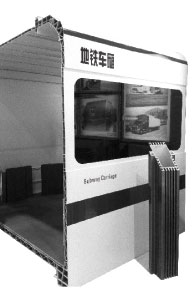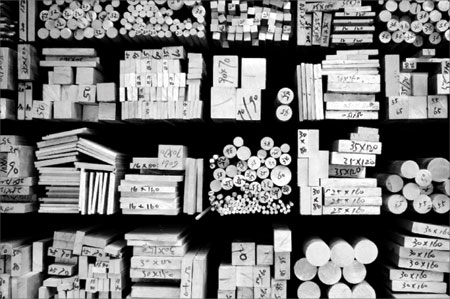Zhongwang seeks domestic safe haven
Updated: 2011-09-09 07:52
By Li Tao(HK Edition)
|
|||||||
|
Photo: Kevin Lee / Bloomberg |

Although exports to the US have been severely hurt by anti-dumping measures on aluminum products, the company said its plan to shift focus to the mainland is starting to bear fruit. Li Tao reports.
In August, China Zhongwang Holdings Ltd, Asia's largest manufacturer of industrial aluminum extrusion parts, reported that the group's net profit for the six months ended June 30, 2011 declined by 80 percent this year to 412 million yuan ($64.5 million) from 2.1 billion a year earlier.
This followed the publication of its 2010 full-year results in March whereby net profits declined 26 percent year-on-year. Zhongwang, which had previously been heavily dependent on the US market, basically halted its exports to that country after the American authorities initiated an anti-dumping and countervailing duties investigation in April of last year.
Nevertheless, Zhongwang's significant improvement in its mainland business suggested that the group's strategic transformation on the distribution of its portfolio has delivered notable results, Vincent Cheung, chief financial officer of the group, told China Daily in an exclusive interview.
According to a statement to the Hong Kong Stock Exchange in August, Zhongwang's revenue from overseas markets stood at 88 million yuan in the first half of 2011 compared with 3.82 billion yuan during the same period last year. And first-half domestic sales, which were reported to have come in at 4.19 billion yuan, are up by 57.9 percent compared with the same period in 2010.
The increases of 94 percent in terms of sales and 87 percent in total revenue quarter-on-quarter to June 30 also point to the fact that Zhongwang's strategic decision to focus on the mainland was successful, according to Cheung.
"The second quarter results are higher than our expectations, as the company successfully increased its domestic market share," Didier Zheng, an analyst from SWS Research wrote in a report dated August 15, 2011, adding that the domestic market accounted for 98 percent of the company's sales in the first half of 2011.
Even though the company's gross margin continued to shrink in the second quarter, driven by much lower processing fees as a result of fierce competition in the domestic market, the company could still make up for that with a higher-than-expected volume of sales, the report added.
Industrial aluminum extrusion products have been widely used in vehicle manufacturing and renewable energy industries. The high profit margin, which could reach up to 50 percent in overseas markets such as the US, attracted a great number of domestic manufacturers including Zhongwang, which was founded in 1993.
Despite the fact that mainland enterprises are late starters compared with other players, sustained investment in key production equipment as well as research and development has enabled the whole industry to expand rapidly on the global market.
Cheung admitted that with the gross profit margin from sales to the overseas market more than double that of the average 20 percent in the domestic market, Zhongwang had previously poured most of its capacity to international markets instead, even though the central government had also unveiled a 4 trillion yuan economic stimulus plan to boost the domestic economy following the global financial meltdown in 2008.
In 2009, Zhongwang sold a total of 160,000 metric tons of products worth more than $800 million to the US, which accounted for almost 41 percent of the group sales.
However, the honeymoon didn't last long after the US Commerce Department initiated investigations in April 2010 on mainland industrial aluminum extrusion product makers - all of which were legally required to deposit the duty owed until a final ruling was reached.
And according to the final countervailing and anti-dumping rulings by the US Commerce Department dated in March, certain aluminum goods imported from China will be subject to a countervailing duty of 374.15 percent and an anti-dumping duty of 33.28 percent over the next five years.
Lu Changqing, vice-president of Zhongwang, said the group timely shifted its focus to the mainland last year, tapping the world's largest market for industrial aluminum extrusion products, as opportunities from sectors including transportation, machinery equipment as well as electric power engineering are expected to offer enormous business potential for the group in the world's second largest economy.
The mainland is no longer a secondary market to Zhongwang, Lu said, adding that the group these days has sealed deals with a number of large mainland enterprises, mostly large state-owned enterprises, which have tremendous exposure to the nation's infrastructure development and other key sectors.
Revenue from the mainland reached 4.18 billion yuan in the first-half of 2011, accounting for 98 percent of the 4.27 billion yuan total.
Meanwhile, the gross margin stood at 20.6 percent during the same period.
Linus Yip, a strategist from First Shanghai Securities said it is critical for Zhongwang to figure out ways to lift the gross margin as compared with the money-making exports to the US, saying that the current level of 20 percent is pretty tight.
"But shares of Zhongwang traded rather smoothly in the Hong Kong Stock Exchange this year, despite the volatility of the global and local equity markets, which suggests that the group is well recovered from the fall in its overseas business," said Yip.
As of June 30 this year, the company had more than 700,000 metric tons of annual output capacity and its products occupied about a 13 percent share of the mainland's industrial aluminum extrusion market, Zhongwang CFO Cheung told China Daily.
According to a market study carried out by Boston Consulting Group last year, the consumption of industrial aluminum extrusion products on the mainland is projected to rise to 3.80 metric million tons and 5.43 million metric tons in 2012 and 2015 respectively.
This compares with consumption of 2.63 million metric tons in 2009.
Besides focusing on the mainland market, the company has not stopped exploring overseas markets including Canada, Australia and Europe to build a diversified revenue base.
"And we are not giving up the US market since we are seeking opportunities to export high value-added products which have not been included in the category of anti-dumping and countervailing duties," according to Lu.
litao@chinadailyhk.com
China Daily
(HK Edition 09/09/2011 page2)
